Momentum is one of the most important concepts in technical analysis. Momentum can be measured by various trading indicators including RSI, Stochastics, Williams %R, and the Momentum Indicator among others.
In this lesson, we will discuss the Momentum Indicator. We will learn what this indicator is, how to calculate it, and what types of signals it provides. With that foundation, we will then discuss some strategies for trading with the Momentum indicator and how it can be combined with other technical studies.
What is the Momentum Technical Indicator?
The Momentum Indicator falls within the Oscillator class of technical trading indicators. The indicator oscillates to and from the 100 centerline, which may or may not be displayed based on the indicator settings. In addition, the Forex Momentum Indicator is considered a leading indicator, which means that it can often foretell potential trend changes before they occur.
The Momentum Indicator essentially measures the rate of change or speed of price movement of a financial instrument. It measures the most recent closing bar to a previous closing bar n periods ago. By analyzing the rate of change, we can gauge the strength or “momentum” in a forex currency pair or financial instrument. Waning momentum suggests that the market is becoming exhausted and may be due for a retracement or reversal. An accelerating momentum condition suggests that the trend is strong and likely to continue. Many momentum trading techniques such as a breakout of a recent range relies on this idea of accelerating momentum.
The Momentum indicator in forex is a very versatile indicator and can be used in several different ways. It can be utilized as a trend confirmation signal, as well as a trend reversal signal. It is the trader’s job to understand the market environment that exists, and apply the most appropriate signal with that context in mind.
For example, in a trending environment, we would want to consider continuation signals, while in a range bound market, we would want to consider Mean Reversion type signals. We will take a closer look at this in the later sections. But for now, it is important to keep in mind, that the Momentum trading indicator provides useful information in both range bound markets, and trending market conditions.
The Momentum indicator consists of a single line, however, many traders also prefer to add a secondary line on the indicator which acts to smooth the signals. The second line is typically an X period Moving Average of the Momentum indicator. A popular setting for the X period look back is 9, 14, or 21. Keep in mind that the shorter the X period setting is, the more noisier the signal can be, which can lead to false signals. Longer period inputs for the X setting will result in better quality signals, however, the signals will tend to occur much later.
Typically, the MT4 Momentum indicator will be displayed in a separate window at the bottom of the chart panel. Let’s take a look at the MT4 chart below which displays the 10 period Momentum indicator, along with the 21 period Simple Moving Average. The Momentum line is shown in blue and the Simple Moving Average is shown in Cyan.
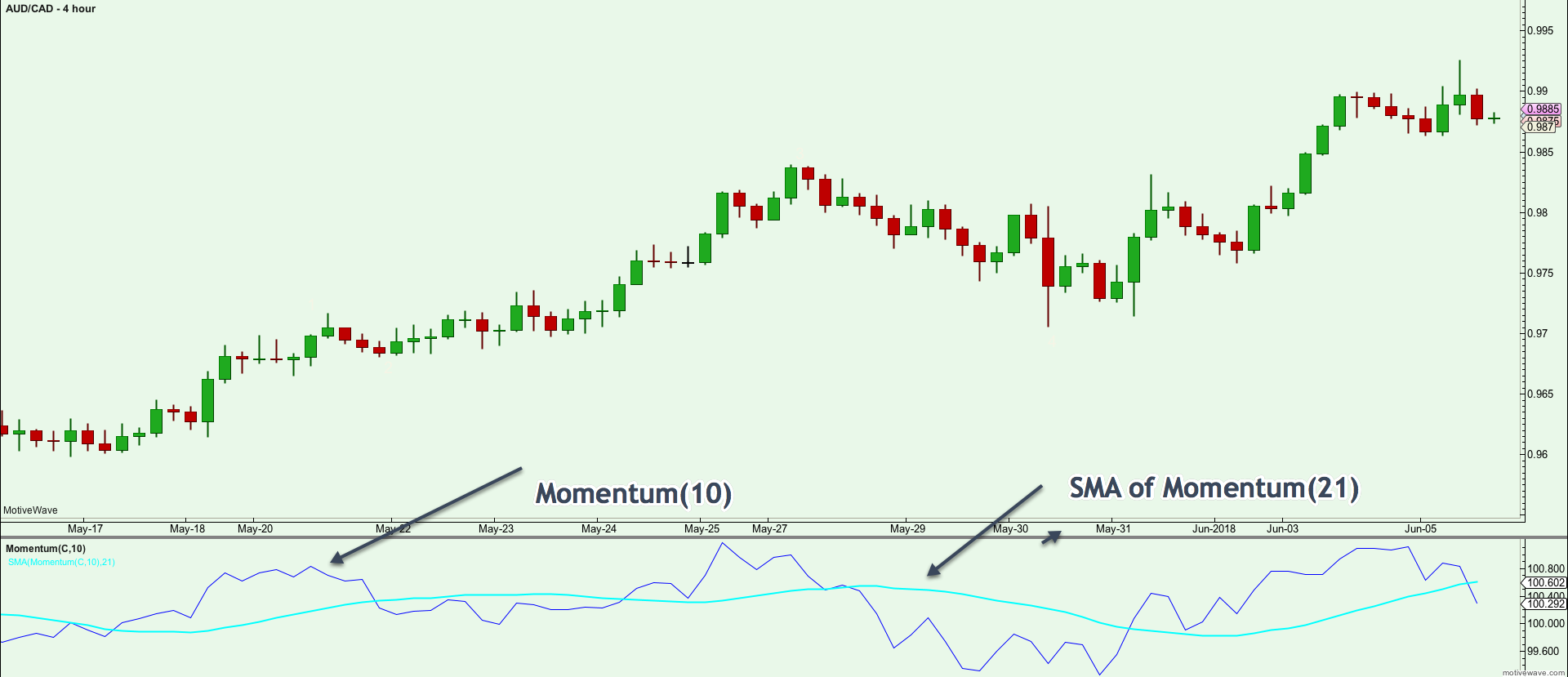
Calculating the Momentum Indicator
The Momentum Indicator compares the current closing price to a specified closing price “n” periods in the past. The “n” period is an input value that is determined by the trader. Most charting software programs use momentum indicator settings of 10 or 14 for the input value. So then, if you set “n” to 10, that would compare the current closing price to the closing price 10 periods ago. Here is the calculation for the Momentum Indicator:
M = (CP / CPn) * 100
Where M = Momentum, CP = Closing Price, n = close price n bars ago.
Let’s take an example using the following inputs:
CP = 109.10
CPn = 102.50
M = (109.10 / 102.50) * 100
M = 106.43
Your charting program will automatically plot the output values, but it is important to understand how the calculation is done.
Momentum Indicator Signals
The forex momentum oscillator helps identify the strength behind price movement. We can use momentum to pinpoint when a market is likely to continue in the direction of the main trend. In addition, the momentum study can help us to identify situations when the price action is losing steam so that we might prepare ourselves for a potential trend reversal. The three primary signals that the Momentum indicator provides is the 100 Line Cross, the Moving Average Cross, and the Divergence signal. We will go through each of these signal types in the following section.
100 Line Cross
One type of signal provided by the Momentum Indicator is the 100 Line Cross. When price moves from below the 100 Line and crosses it to the upside, it indicates that prices are moving higher and that you may want to trade from the bullish side. And similarly, when price moves from above the 100 Line and crosses it to the downside, it indicates that prices are moving lower and that you may want to trade from the bearish side.
Keep in mind, that you should not use the 100 Line cross in isolation as it can be prone to whipsawing. The point is to keep an eye out for where price is in relation to the 100 Line and use other filters to find the best entry opportunities. For example, in an uptrend, you may want to wait for prices to pullback to or below the 100 line from above, and enter after price crosses back above the 100 line. You could filter that condition with something such as a 3 bar breakout for entry.
Take a look at the chart below which illustrates this:
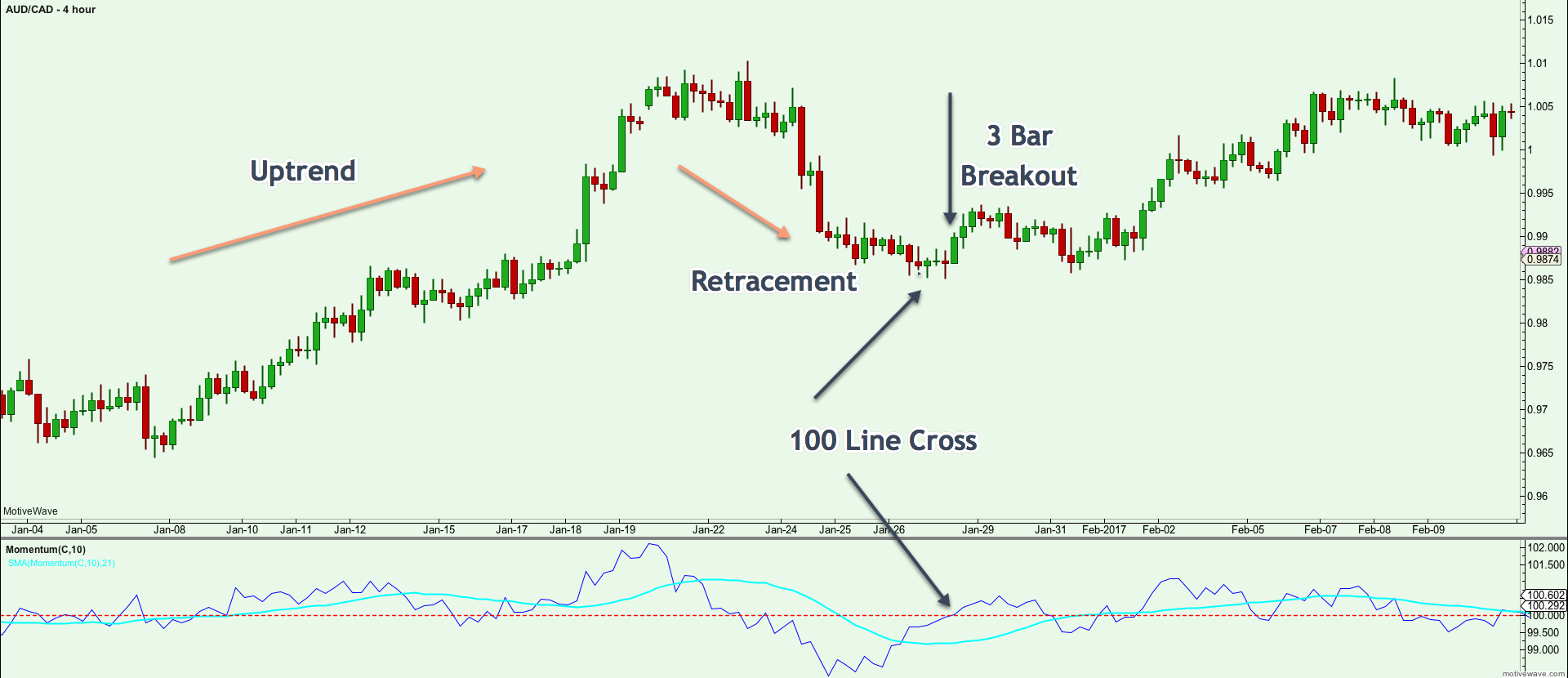
Crossover Signal
As we noted before, you can add a second line to the Momentum Chart Indicator. Typically, that would be a Simple Moving Average of the Momentum Indicator itself. The length of the moving average could be whatever the trader chooses, but a common setting is a 10, 14, or 21 period moving average. You must have both the Momentum line and the MA line plotted in order to utilize the crossover signal.
The basic idea is to buy when the momentum line crosses the Moving average from below, and sell when the momentum line crosses the Moving average from above. This by itself would be a very rudimentary application, but we can enhance these types of signals by taking trades only in the direction of the underlying trend or taking signals only after an Overbought or Oversold condition has been met. Take a look at the chart below which shows a Momentum Crossover Buy Signal coupled with an RSI oversold reading.
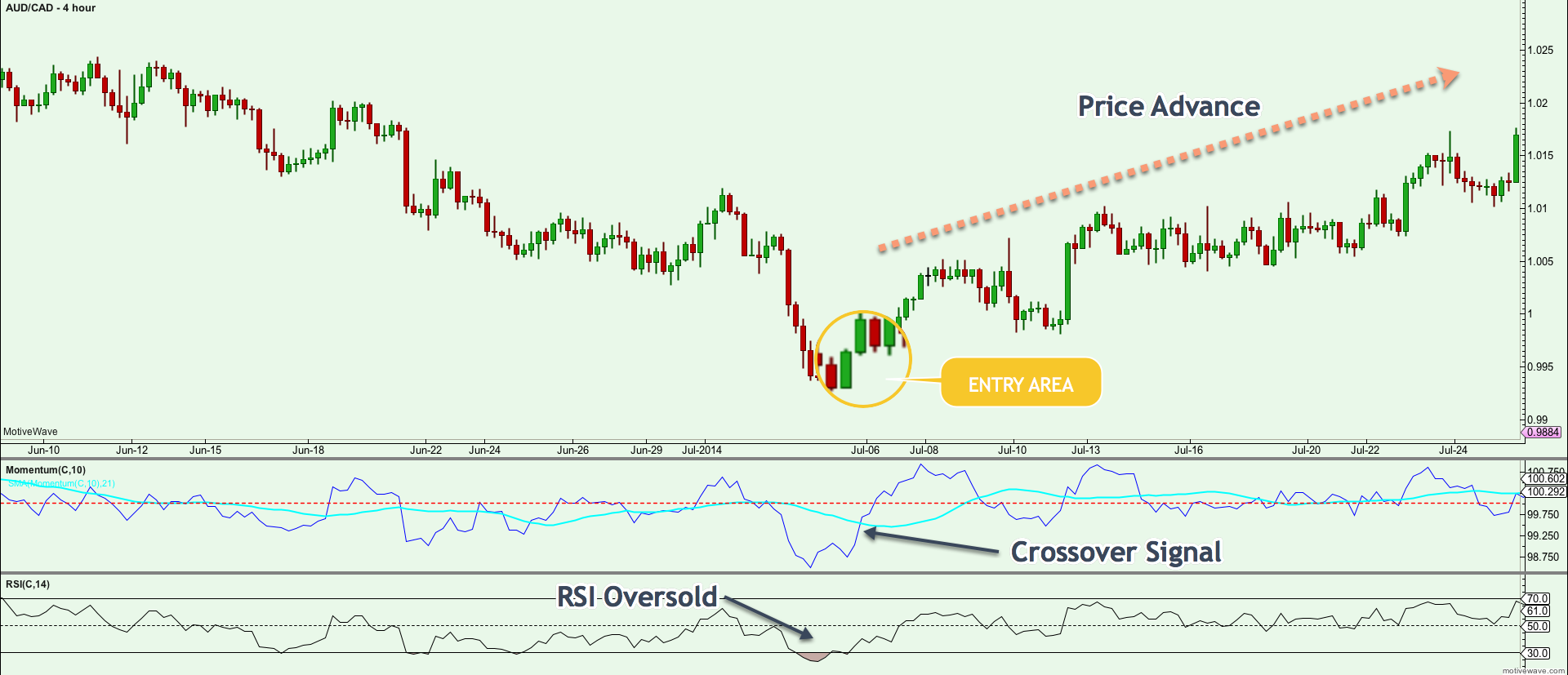
Momentum Divergence Signals
Momentum Divergence is a very simple but powerful concept in technical analysis. A bullish divergence occurs when prices are making lower lows, but the Momentum indicator (or other oscillator) is making a higher lows. On the same line of thinking, a bearish divergence occurs when prices are making a higher high, but the Momentum indicator (or other oscillator) is making a lower high.
This dichotomy or divergence provides early clues to the trader of weakening momentum which could lead to a price retracement or a complete trend reversal. Momentum divergences tend to occur at market extremes where prices have pushed too far, and like a rubber band effect, it needs to revert into a value area.
Divergences work well in range bound market conditions. But during strong trending markets, divergences will tend to give many false signals along the way. And so, it is important not to use divergence in isolation. Understanding what is occurring on the larger time frame is often very helpful in filtering out low probability trades. Looking for key support and resistance areas and using that as a backdrop to lean on a divergence setup can increase your odds of a winning trade substantially.
During a trending market condition, you can also look for a pullback where price action is diverging from the Momentum indicator. A divergence trade setup that is aligned with the overall trend is likely to provide a higher success rate, than bucking a strong trend and trying to pick a top or bottom. When attempting a counter trend trade with momentum divergence, it is important that you have additional evidence that a trend reversal is likely. No matter how far a market has extended or how good a counter trend divergence signal looks, it could very well be a false signal, and the market could continue to trend. Keep in the mind the old adage that says, “the markets can remain irrational for longer than you can remain solvent”.
Let’s take a look at a few divergence examples. The first example below occurs within a range bound market.
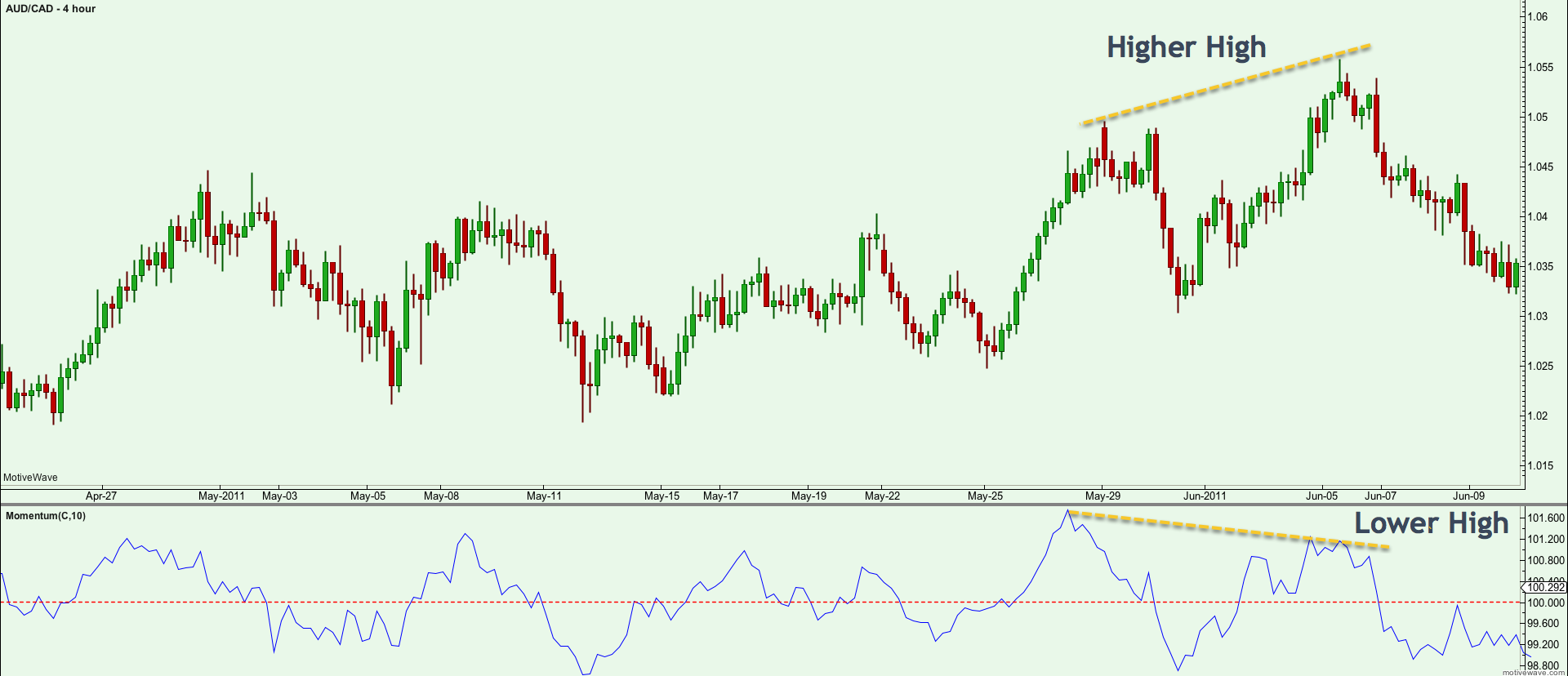
Take note on the far right of the chart, price action makes a higher high and the Momentum Oscillator makes a lower higher. This is a good quality divergence setup that occurs within a range bound market condition. Now let’s take a look at some momentum divergences that occurred during a strong price decline.
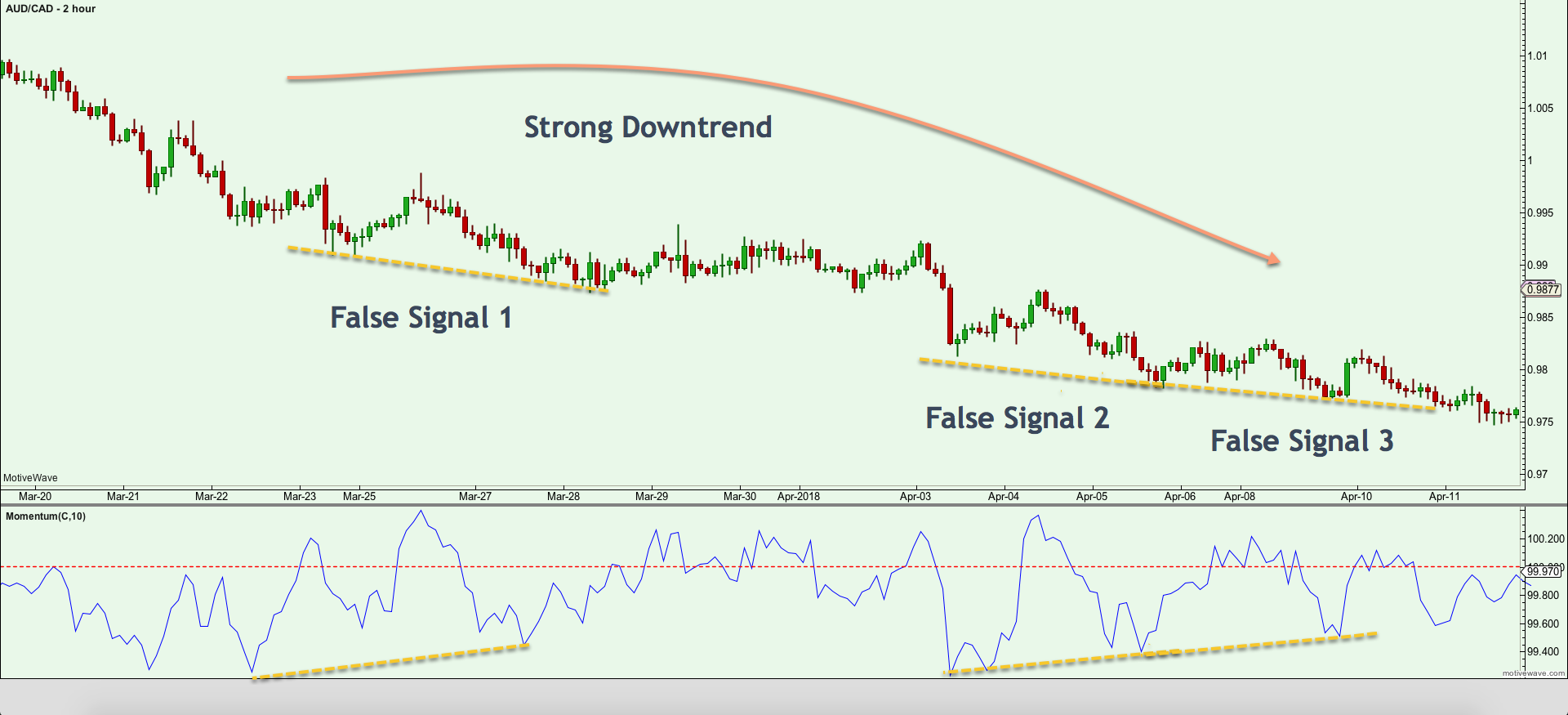
On the chart above, you will notice that price is in a strong downtrend. There are three Momentum divergence signals noted on the chart. All three proved to be false signals as price action continued to trend to the downside. This should make you think twice about trading divergences during strong trends.
Trading Strategy using Momentum Indicator
By now you should have a good understanding of what the Momentum indicator is, how it is constructed, and some of the trading signals that it provides. We will now shift our focus and discuss some trading strategies that we can use when trading with Momentum.
Momentum Divergence with Zig Zag Pattern
The first Momentum system that we will discuss combines the Momentum Indicator, Divergence setup, and the Zig Zag pattern. We have already outlined the details of the divergence pattern, so now I will briefly explain what a Zig Zag Pattern is.
A Zig Zag Pattern is a fairly simple pattern that is rooted in the Elliott Wave theory. It consists of three waves – A, B, and C. Wave A is the initial wave of the pattern, which is retracement by the second leg, Wave B. Wave B must retrace less than 100% of Wave A. The final wave, Wave C, moves in the same direction as Wave A and must extend beyond it. Here is a diagram which illustrate the Zig Zag pattern:
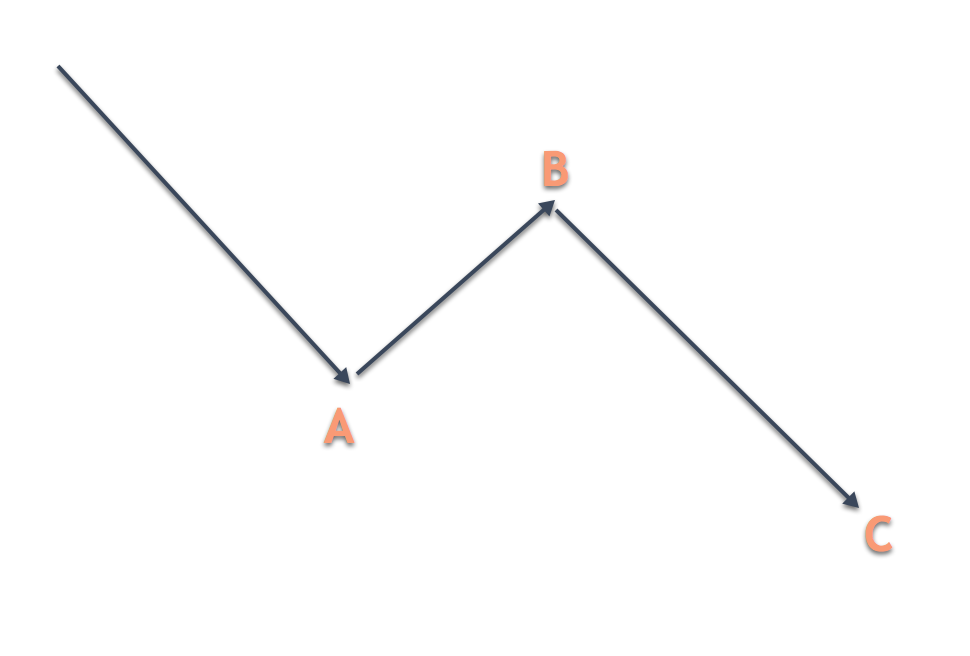
So now let’s combine all three elements to create the trading strategy. Firstly, what we are looking for is an overall trending market. Secondly, we want to see a Zig Zag correction within that trending market. And then, finally we want to wait to see if a divergence formation occurs within the Zig Zag pattern.
If we can confirm the divergence between the Momentum indicator and price, then that will be our trade setup. Our actual entry signal will occur on the break of the trend line that extends from the beginning of Wave A and connects to the beginning of Wave C. We will call this the A-C trend line.
As for trade management, we will look to place our stop loss beyond the most recent swing created prior to the A-C trend line breakout. And for the take profit target, we will target an area just inside the beginning of Wave A.
Let’s take a look at this Momentum Divergence with Zig Zag setup in action:

The currency chart above shows the price action on the 4 hr. USD/CHF pair. You can see from the far left of the chart, that the USD/CHF pair has been in a steady downtrend. At some point, price action begins to turn up and soon we see a Zig Zag pattern forming on the chart. Also at the same time, we see that a Bearish Divergence pattern is forming as well between the price and the Momentum Indicator. The dashed yellow lines represent the divergence formation. All of this evidence points to a possible reversal, so we want to be positioned to the short side.
Recall per the strategy described, we would want to wait until we have a break and close beyond the A-C trend line of the Zig Zag pattern. You will notice the A-C trend line is marked with a dashed red line. Sometime after the divergence pattern has formed, we have a strong break and close beyond the A-C trendline. This is the entry signal that we are waiting for, and we would want to initiate a short trade here.
The stop loss would be placed just above the Pin Bar that was created several bars back. You can spot this by locating the bar with the relatively high wick to the upside. Just after the entry, price action tested the broken A-C trendline and then moved sharply to the downside. We would exit the trade just before price reaches the beginning of the Zig Zag pattern. I have noted the take profit target area on the chart.
Momentum Divergence with Support and Resistance
Regardless of the trading system used, every trader should take the time to understand the fundamental concepts of Support and Resistance. Support levels are areas where price is likely to stall or find demand (buying pressure). Resistance levels are areas where price is likely to stall of find supply (selling pressure). When a support level breaks, it turns into new resistance. When a resistance level breaks, it turns into new support. It is important to note that Support and Resistance should be viewed as zones or areas rather than a fixed line.
One of the major mistakes that traders make is that they typically only look at one timeframe – their trading timeframe. By doing this, they lose sight of what is going on in the bigger picture and sometimes trade right into a key support and resistance level without even knowing it. So, it is critical to know where major support and resistance areas are so that you can navigate your trading within that framework.
In this next strategy, we will be combining the Momentum indicator using the divergence pattern again, but this time we will trade the divergence off of a key higher timeframe level. So, if you were trading the 60 minute chart, your key levels would be plotted off the 240 minute chart, which is the next higher timeframe. Or if you were trading the 240 minute chart, your key levels would be plotted off the daily chart. Typically, the higher timeframe will be 4x to 6x your trading timeframe.
In this Momentum strategy, we will first wait for price to approach a key S/R level based on the higher timeframe. Then, we want to watch the price action closely and wait to see if a divergence pattern forms near the S/R level. Once we confirm the divergence between the Momentum Oscillator and price has occurred, then we will consider that a potential trade setup is progressing. Our actual entry signal will occur on Momentum Indicator crossover.
We will need to place a stop loss order in the market. For the stop loss, we will use the most recent swing prior to the Momentum crossover signal. For the exit, we will wait for the Momentum Indicator crossover in the opposite direction.
Let’s look at an example of this Momentum Indicator strategy in the market.
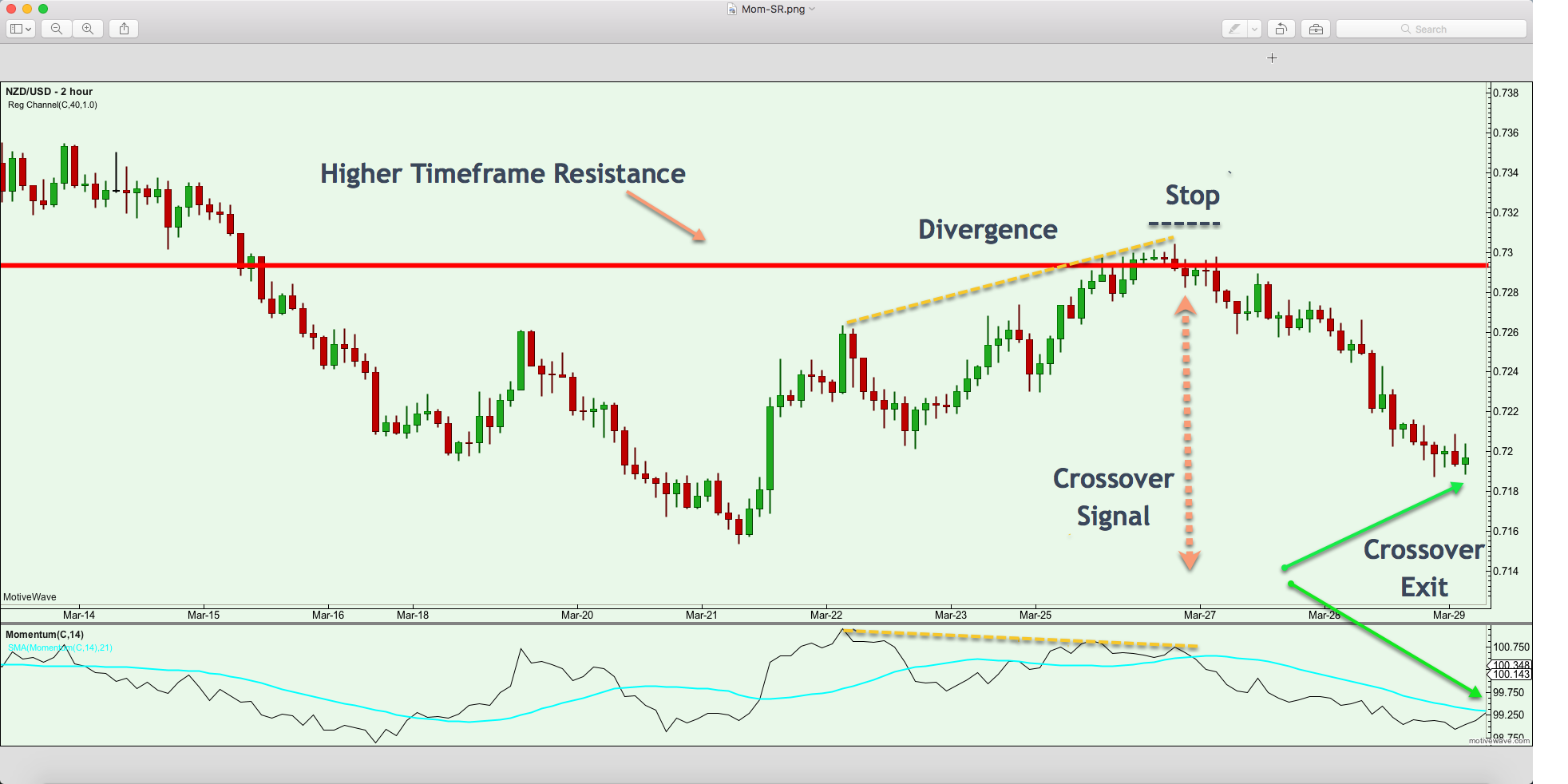
The above chart displays the price action for the NZDUSD pair on the 2 hr. timeframe. Take note of the solid red line on the chart. That red line represents key resistance area for the 10 hr. timeframe. Keep in mind for this strategy, we want to use the higher timeframe to mark major support and resistance levels.
We can see from the price action beginning at the left side of the chart, that the NZDUSD was in a downtrend. As the down move began to subside, prices started to reverse and trade to the upside. Price action put in the first significant top during the up move, and soon after price action was beginning to test the major resistance area. As price moved into resistance, we were able to notice that a nice divergence pattern was forming as well. This clued us into a potential bearish trade setup.
Based on the strategy rules described, we would have to wait for the Momentum indicator crossover signal now before we could execute the trade. And in fact, that signal occurred shortly after the resistance test. As a result, we would have entered a short position and placed our stop loss order above the recent swing high as noted on the chart. Prices quickly dropped and several days later a crossover signal occurred to the long side on the Momentum indicator. This crossover serves as our exit and we can close the trade with a nice profit on the trade.
Conclusion
As we have discussed, there are three primary trading signals that can be generated with the Momentum Indicator. These signals include the 100 Line Cross, the Momentum Crossover, and the Divergence signal. The best Momentum indicator signal is the Divergence signal. But regardless of which type of Momentum signal you employ, it is highly recommended that you make use of confluence by incorporating other technical studies into the mix. You should not trade the Momentum indicator without first analyzing the underlying market condition. If you stick to that guideline, then you will be less prone to whipsaws and false setups.
You should now be more knowledgeable about the Momentum Indicator as well as more comfortable with applying it in the market. We have discussed some strategies that can be incorporated using the Momentum Oscillator, but that should only serve as a basic building block from which you can test different ideas or find valuable ways to incorporate it within the context of your own trading plan.